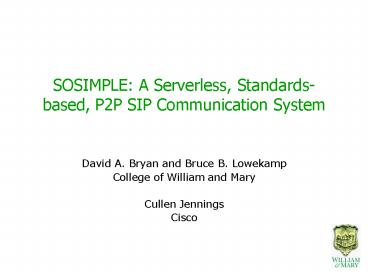SOSIMPLE: A Serverless, Standardsbased, P2P SIP Communication System PowerPoint PPT Presentation
1 / 27
Title: SOSIMPLE: A Serverless, Standardsbased, P2P SIP Communication System
1
SOSIMPLE A Serverless, Standards-based, P2P SIP
Communication System
- David A. Bryan and Bruce B. Lowekamp
- College of William and Mary
- Cullen Jennings
- Cisco
2
VoIP/IM
- VoIP Voice over IP (Internet Protocol)
- IM Instant Messaging (such as AOL)
- Common components
- Resource location
- Session establishment and management
- Presence
- SIP IETF standard supporting VoIP
- SIMPLE IM extensions to SIP
3
Problems with Traditional Architecture
4
SOSIMPLE
- Self-Organizing SIMPLE
- Based on existing SIP/SIMPLE architecture
- Incorporates P2P technology for
- Scalability
- Secure messages
- Ad-hoc or limited connectivity
- Draft submitted to IETF
5
Talk Outline
- Introduction
- SIP/SIMPLE
- Motivating Scenarios
- Requirements
- SOSIMPLE Architecture
- Security and Performance
6
SIP/SIMPLE
- SIP
- IETF (Internet Engineering Task Force) defined a
protocol for VoIP, called SIP - Designed for packet networks, useful for any sort
of multimedia session establishment - Support for integration with email/web services
- SIMPLE is a set of extensions to SIP to support
instant messaging
7
Why SIP?
- Widely used today for VoIP and IM
- Vonage, Microsoft MSN
- Large investment
- (phones, gateways)
- Effort (applications, stacks)
- Reuse/cheap COTS devices
- SIP is extensible we can extend for P2P
- Used SIPs REGISTRATION support
8
Scenario Small Organization
- Traditional VoIP and IM systems use centralized
servers. - Not appropriate for private messages.
- Internal chat systems used.
- Not compatible with external users.
9
Scenario No Internet Connectivity
- Disaster management
- Remote locations
- ISP failure
10
Scenario Ad-hoc Groups
- Meetings, classrooms, and conferences
- Desire to establish quick connectivity between
those present. - No need to configure a server.
11
Scenarios Access Scalability
- Censorship always a problem
- Government censorship
- Corporate/ISP censorship
- Scalability
- Reliability
- Easy to join
- Cheap!
12
Scalability Requirements
- No central server
- No central naming authority
- Simple system discovery
- Scalable number of users
13
Usability Requirements
- Privacy
- Multiple realms
- Interconnection
- User mobility
- Compatibility and reuse
14
Why P2P SIP?
- SIP/SIMPLE are existing standards
- widely used commercially
- supports both voice and IM
- P2P meets many of our requirements
- SIP is easily extensible to implement P2P
- Different than file-sharing
- false negatives unacceptable
- anonymity undesirable
15
SOSIMPLE Messages
- Basic approach is a DHT
- current implementation based on Chord
- All messages are SIP messages
- SIP headers extensible
- Modify REGISTER for node and user registration
- Traditional use of REGISTER sending user location
information to registrar - Now send user location to peer
- Also used for node registration
16
Why Use SIP Messages?
- No standard P2P protocol implementation
- Existing filesharing applications generally not
appropriately extensible - Filesharing most commonly blocked apps
- Many firewalls already recognize SIP
- OpenDHT emerging standard
- Centralized super-peers
- Still need independent P2P for private nets,
hierarchies, and infrastructureless modes
17
Node Joining
Joining Node Node-ID 503
1. REGISTER
Bootstrap Node Node-ID 023
302 Node B
2. REGISTER
Node B Node-ID 245
302 Node C
3. REGISTER
200 OK
Node C Node-ID 520
4. Joining node after join Node-ID 503
- Iterative search increases reliability
18
User Registration
Alices Node Node-ID 503
Node A Node-ID 023
Node B Node-ID 245
Alice-gt Alices Node
Alice -gt 234
Node C Node-ID 520
Alices Node Node-ID 503
- Users node must register in DHT
SIP REGISTER used for nodes and users
19
Contacting a User
Node A Node-ID 023
Bob-gt Bobs Node
Bobs Node Node-ID 683
1. INVITE
302 Bobs Node
Node B Node-ID 245
2. INVITE
Alice-gt Alices Node
Alice -gt 234 Bob -gt 723
Node C Node-ID 520
Alices Node Node-ID 503
- DHT used for initial location
SIP INVITE/MESSAGE used for location
20
Session Establishment
Node A Node-ID 023
Bob-gt Bobs Node
Bobs Node Node-ID 683
Node B Node-ID 245
Alice-gt Alices Node
Alice -gt 234 Bob -gt 723
Node C Node-ID 520
Alices Node Node-ID 503
- Standard SIP used for connection
- No reliance on DHT
21
Presence
- Buddies located upon joining
- Serve as additional finger table entries
22
Security Concerns
- User Authentication
- Routing
- NAT Traversal
23
User Authentication
- Need to know who were talking to, but
- There is no way to establish initial identity
- AIM, etc. provide no way to lookup handle
- Initial authentication
- Email addresses
- PGP web of trust
- CAs
- Face to face
- Big question Is this the same person Ive talked
with before?
24
User Authentication
- User authentication easy with public key
- Duplicate IDs necessary evil
- Can specify CA as source
- User mobility requires storing user profiles in
network, relying on password encryption - Some aspects of user authentication harder
without trusted nodes (email addresses)
25
Routing
- Can we trust other nodes?
- DOS attacks by misrouting queries
- Iterative search simplifies problem
- DHT traversal unimportant after location
- Buddies locations cached
- Media routed end-to-end
- Social routing
- Finger table size
26
Related Work
- Skype
- Singh and Schulzrinne, NOSSDAV 2005
- SPROUT
- OpenDHT
27
Conclusions
- P2P ideal for user location
- SIP gives compatibility with existing tech
- P2P can never be fully secure
- Need to provide reliability with untrustworthy
nodes and users - IETF draft submitted
- http//www.p2psip.org/
- http//www.cs.wm.edu/bryan/lowekamp

